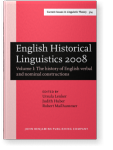Tracking and explaining variation and change in the grammar of American English
A case study, with evidence from the TIME Corpus
Both to infinitive and to -ing complement clauses selected by adjectival heads may involve subject control in English, but there are syntactic differences between them. In spite of the differences, some matrix predicates have shown variation and change between the two types of sentential complement in recent times. The article examines the adjective accustomed from this point of view, with evidence from the TIME Corpus. It is observed that in the first decade covered by the corpus, from 1923 through 1932, to infinitives were slightly more frequent than to -ing complements, but that in the 1960s the to -ing pattern had become predominant in comparison with the to infinitive pattern. The article points to such variation and change affecting the sentential complements of accustomed in one particular text type of American English, and identifies two explanatory principles to account for the variation observed. The first is the Extraction Principle, which is defined more broadly than in some earlier work, and the second is the postulation of a semantic contrast between the two complementation patterns. It is argued that both the Extraction Principle and the semantic distinction are statistically significant in explaining variation at one stage in the overall process of change that has been called the Great Complement Shift.
Cited by (1)
Cited by one other publication
ROHDENBURG, GÜNTER
2016.
Testing two processing principles with respect to the extraction of elements out of complement clauses in English.
English Language and Linguistics 20:3
► pp. 463 ff.

This list is based on CrossRef data as of 20 july 2024. Please note that it may not be complete. Sources presented here have been supplied by the respective publishers.
Any errors therein should be reported to them.
